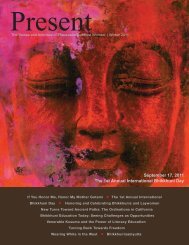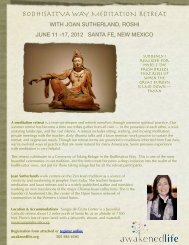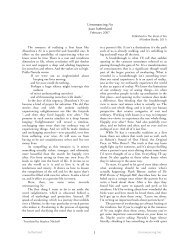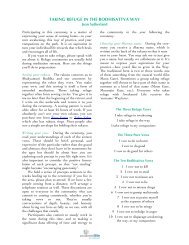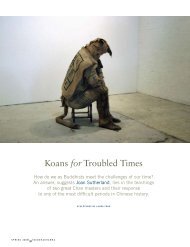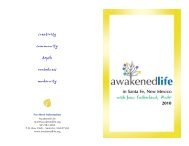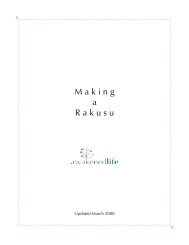Gaining Perspective - Awakened Life
Gaining Perspective - Awakened Life
Gaining Perspective - Awakened Life
- No tags were found...
Create successful ePaper yourself
Turn your PDF publications into a flip-book with our unique Google optimized e-Paper software.
(Opposite)Untitled, 2005by Vivienne Flesherjennifer brinkmanin childhood, trying to keep us from getting into trouble. Itreviews our mistakes endlessly, in an attempt to prevent futureerrors or failures. It believes that the best way to ensure ourhappiness is to berate us about our shortcomings. It doesn’trealize that it is also stealing our innate capacity for happiness.As we grow older, it can infiltrate our mind so thoroughly thatwe don’t realize that we have fallen into a pervasively negativepattern of thinking aboutourselves. When this happens,people begin to think ofthemselves as “defective” or‘broken.”I point out to students thatthey would never rent andwatch the same painful movie two hundred and fifty times.And yet they allow their mind to play painful episodes fromthe past over and over. “Remember when you made that stupidmistake? Let’s run that mind movie again, and again, andagain.” We need to tell the Inner Critic that we aren’t stupid.We only need to review our past mistakes once or twice, thenmove on with determination to change.It helps to get some perspective on the damage a strongInner Critic can do. Imagine that you heard a mother in asupermarket saying out loud to her three-year-old child whatyour Inner Critic says to you. “You’re an idiot! I’ve told youa million times not to do that. You’re hopeless!” We wouldall recognize these statements as harmful, or even abusive. Noone, a child, a pet, or a plant, can thrive under that pattern ofnegative attack. And yet we allow our Inner Critic to attackus in this way, repeatedly.The Buddha was quite clearabout not giving energy toafflictive thoughts. He divided allhis thoughts into two classes, thosethat led to enlightenment and thoseJust as the Buddha recognized Mara,we need to recognize the Inner Criticnot as the truth but as a single voiceamong many.Jan Chozen Bays is co-abbot of Great VowZen Monastery in Clatskanie, Oregon, whereshe leads workshops on transforming theInner Critic. Her forthcoming book is How toTrain a Wild Elephant & Other Adventures inMindfulness (Shambhala Publications, July).that led away. He cultivated the former and put aside the latter.If you recognize the Inner Critic and stop feeding it mentalenergy, its power will weaken.How can we cultivate a voice to subdue the Inner Critic?Through metta, loving-kindness practice. We can meditate asthe Buddha did, full of compassion for living beings—includingourselves. We can breathe out the silent phrases, “May I be freefrom anxiety and fear. MayI be at ease.” We can evendirect these phrases towardthe Inner Critic, because thisis the very part of us thatis chronically anxious andfearful. It is desperately afraidthat we will make a mistake, lose our job, be unloved, becomehomeless, grow old, become ill and die—which of course,eventually, we will.Indeed, there is often a kernel of truth in what the InnerCritic says. Yes, I was drowsy during that last meditationperiod. However, that does not mean that I am bad, stupid, orhopeless. It just means that I had a sleepy period. Now I willdrop the past and do my best during the next period. Whenwe can hear what the Critic says and take away the anger,the sting, the invidious comparisons of self and other, then itis transformed into the voice of discriminating wisdom anddetermination.Ultimately, the only sure cure for the Inner Critic is topractice. The Critic relies upon an idea of a self—a small self—that is imperfect and must be fixed. It feeds on comparing, onthoughts of past and future, of mistakes and anxieties. TheInner Critic has no traction in the present moment. When ourminds become quiet, when we are resting in this very moment,there is no past or future, there is no comparing. The small selfexpands to become a huge field of calm awareness in whichsensations, thoughts, and voices come and go. Everything isjust as it is, perfect in its own place, interconnected with everyother piece of the whole. Every being also is perfect as it is,including the temporary collection of energy we call our self.Every morning at the monastery we remind ourselves ofthis truth as we chant, “buddhanature pervades the wholeuniverse, existing right here now.” In us, as us. Nothing isbroken.35summer 2011 buddhadharma: the practitioner’s quarterly




